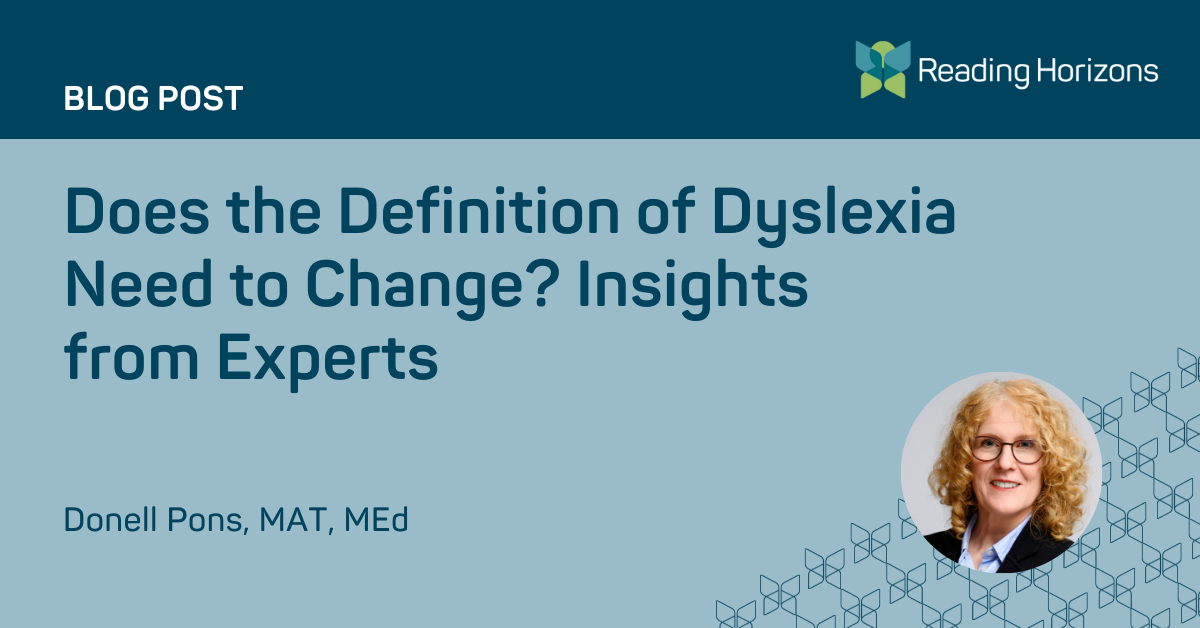
BY Donell Pons, MAT, MEd
In recent discussions surrounding dyslexia, a pivotal question has emerged: should we rethink its definition? As we explore this conversation, it’s essential to consider how a more nuanced understanding of dyslexia could better support diverse learners and enhance instructional practices.
Revisiting Dyslexia at the Big Sky Literacy Summit
The question of a new definition of dyslexia recently surfaced as the subject of a panel discussion at the 2024 Big Sky Literacy Summit in Montana. I’ve had the pleasure of attending this relatively small gathering, around 700 participants, for two years, and this year was even better than the last. Dr. Danielle “Nell” Thompson and her team of extremely congenial volunteers deserve commendation for putting together a well-rounded program of presentations and grand-round discussions covering various topics, from leadership to the implications of defining or redefining dyslexia.
As I mentioned, numerous fascinating topics of conversation emerged from this year’s conference. However, I want to focus on the panel discussion featuring the following speakers:
- Dr. Tim Odegard
- Dr. Charles Hulme
- Dr. Julie Washington
- Dr. Tiffany Hogan
- Dr. Hugh Catts
- Dr. Margaret Snowling
This is an impressive line-up, by anyone’s estimation. Snowling and Hulme may be new names for some, as they are affiliated with the Oxford University ecosystem. Nevertheless, their work is extensive, particularly regarding the impressive language screener and intervention program called NELI (Nuffield Early Language Intervention). Dr. Hulme previously shared some compelling studies about NELI, and the results were impressive. However, here, I will confine my attention to the panel discussion.
Dr. Tim Odegard, a leading figure in reading instruction and dyslexia research, initiated the discussion by recounting a recent experience at this year’s Society for the Scientific Study of Reading Conference in Copenhagen, Denmark. The “experience” involved a presentation arguing that dyslexia is a myth. Fortunately, some of the foremost experts in dyslexia research quickly refuted this claim. However, this incident was the basis for the Big Sky panel discussion about whether the definition of dyslexia should be altered.
Exploring the Need for a New Definition
This is not a new conversation and will likely persist. The definition is important as it often functions as a touchpoint for so many people: researchers, clinicians, legislators, administrators, educators, parents, and most importantly, the folks who have dyslexia. Having a definition that meets the needs of all these groups is challenging. Currently, the International Dyslexia Association gives the following definition:
Dyslexia is a specific learning disability that is neurobiological in origin. It is characterized by difficulties with accurate and/or fluent word recognition and by poor spelling and decoding abilities. These difficulties typically result from a deficit in the phonological component of language that is often unexpected in relation to other cognitive abilities and the provision of effective classroom instruction. Secondary consequences may include problems in reading comprehension and reduced reading experience that can impede growth of vocabulary and background knowledge. (IDA Board of Directors, 2002)
I don’t have room to pull this definition apart fully, but if you’re interested in understanding the rationale behind this definition, I recommend reading “Do We Need a New Definition of Dyslexia” by Emerson Dickman, J.D. (2016). The main point is this definition is widely used to define dyslexia in the United States and can be found in the wording of legislation in most states. But does this need to change? Is the definition helpful or harmful? Should a new definition be considered, and what should it include that isn’t already addressed by the current definition?
Drs. Snowling and Hulme address this very question in a recent article, “Do we really need a new definition of dyslexia? A commentary,” published in The Annals of Dyslexia, March 2024. From the beginning, Snowling and Hulme point this out:
We agree that dyslexia is best thought of as a dimensional disorder, with the best established causal risk factor being a deficit in phonological processing. (Snowling and Hulme, 2024)
Dyslexia as a Spectrum
Dimensional focuses on the extent to which the person will manifest a disorder, thus acknowledging the spectrum or continuum that represents the different levels of presentation associated with dyslexia.
For example, in my own household, the variation between my husband and son with dyslexia is quite significant. Where my husband could come close enough to a spelling or pronunciation through years of effort, my son wasn’t coming close. Dyslexia is a spectrum, and my son presented as a more severe case than my husband. However, my husband recognized the familiar struggles with seeing and hearing letter names and sounds and still laboring to reproduce them. He also relied heavily on the alphabet song to orient him to the letters. They never became “automatic.”
This nuance is important when discussing the usefulness and utility of a diagnosis that relies on a definition of dyslexia.
Knowing dyslexia is “particularly common in children from families with a history of dyslexia and in children with preschool language difficulties” may be useful in an early education setting and for couples planning on having children. Additionally, Snowling and Hulme argue that having definitions that differ depending on their purpose may be useful. Snowling brought this up during the panel discussion, and I found it compelling. With this in mind, there could be a definition that provides more insight in the clinical space, while another definition may provide more guidance for parents who need to drive the instruction and support for their child. It opened my mind to this approach’s potential when discussing dyslexia with different groups.
A Personal Perspective
As a parent, I had no idea what dyslexia actually meant until I stumbled blindly toward challenges that the definition and diagnosis simply didn’t prepare me to handle. For example, the diagnosis never helped me understand what needed to happen in the most important early years of instruction. In Snowling’s explanation of definitions, she gave the example of telling parents in her clinical setting that their child has the profile of someone with dyslexia and focused more on what can be done during instruction to change a fixed outcome. This is hugely important in terms of moving from a fixed notion of what having the profile of dyslexia means.
For my husband, Curtis, who was an adult when he finally received an explanation for his life-long challenges with reading and spelling, the definition didn’t offer resources and support for what was impacting him most: engaging with learning environments that could lead to better job outcomes and supports that could help with everyday literacy needs like reading real estate documents or sending emails. However, the definition freed him from feeling “stupid,” something the word dyslexia finally explained, but what to do from there was still unclear.
Rethinking How We Approach Dyslexia
I’d never envisioned an understanding of dyslexia that could allow for different definitions given the individual student profile. Maybe this is where we should focus: providing enough of a definition of dyslexia to broadly screen and provide intervention for students who are “at risk” because of various identifying factors for reading difficulty. This would align with what Hulme presented regarding NELI, the language screener.
What harm is there in an initially broader idea of reading and spelling challenges that become more specific based on the student’s performance in educational settings? As Steve Dysktra is fond of reminding us, teachers can spot kids with dyslexia faster than diagnosticians, who have to simulate the activities that allow us to see dyslexia. In other words, the classroom is where dyslexia manifests itself most apparently.
So, we begin to sweep more students more broadly to get excellent instruction in foundational skills, and then we think about specific definitions for narrower purposes. What I’ve just taken a few paragraphs to describe is excellent tier 1 instruction with a well-trained educator supported by a tiered system allowing for more intensive instruction for students who need it.
I think we need to have this “Do we need a new definition of dyslexia?” conversation more often because it brings us back to the fundamentals of excellent language instruction.
Download Donell’s e-book: Dyslexia—What Every Educator Needs to Know.
About the author: Donell Pons, MAT, MEd, is president of the International Dyslexia Association Utah Chapter, a dedicated reading specialist, and dyslexia screener and advocate.

